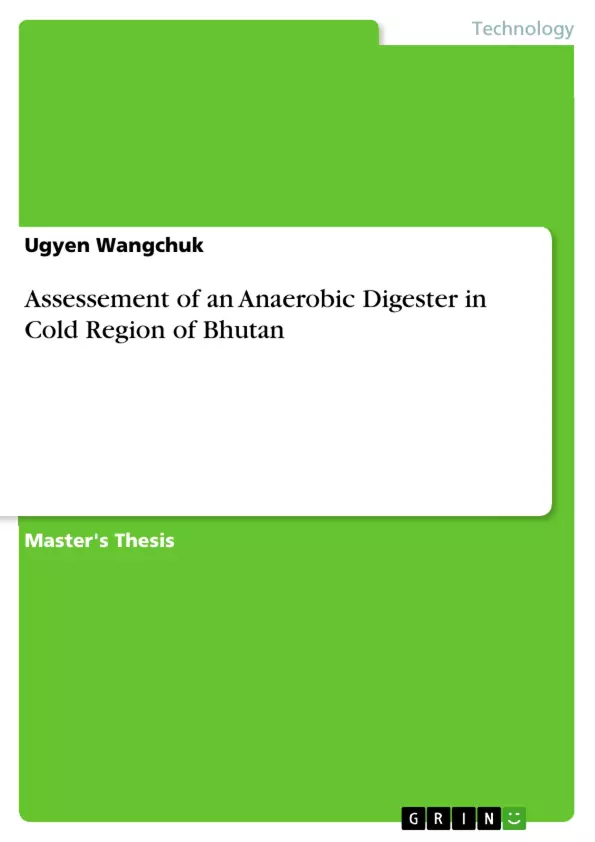A challenge to expand biogas production by psychrophilic digestion to colder regions lies in the fact that gas production decreases with temperature and becomes insignificant when temperature drops below 15℃. The thesis assess the feasibility of operating a biogas reactor in colder climates of Bhutan by simulating the thermal loss of modified reactor designs. The digestion temperature is set to 35℃, an optimum temperature using cow manure fed on daily basis. The analysis emphasesto the regions where the monthly average temperature drops below 12 ℃ .
The designed underground fixed dome digester of 5.5 m3 capacity is analyzed by applying the numerical thermal model. First the digester is insulated with 0.4 m thick rice straw which is cheap and locally available material. From the daily biogas yield of 1.44 m3 comprising 60% of methane, the energy content derived is 6.64 kWh/m. For the uninsulated digester, external heating elements would have to deliver 181.27 kWh/day to compensate the thermal losses. Increasing the insulation thickness to 1 m is insignificant. Secondly, the reactor is placed inside a greenhouse to increase ambient temperature by 10℃. The average heat loss obtained is 22.50 kWh/day. The calculation shows that even with the proposed improvements in reactor design, it is not energetically feasible to operate in the assessed colder region. The alternative method is to increases the hydraulic retention time but this increases the volume of the digester and cost which limits the affordability of the biogas plant by the rural people. Most reasonable method is to decrease the operating temperature between 18℃ and 28℃. Hence, to expand the dissemination of biogas plants in cold regions in Bhutan further improvements in the design and process efficiency and feasibility study of the heating system are necessary.
Inhaltsverzeichnis (Table of Contents)
- Abstract
- List of Abbreviations
- Chapter 1: Introduction
- 1.1 Background
- 1.2 Literature Review
- 1.2.1 Anaerobic Digestion
- 1.2.2 Factors Affecting Biogas Production
- 1.2.3 Biogas Production in Cold Regions
- 1.3 Objectives
- 1.4 Methodology
- Chapter 2: Materials and Methods
- 2.1 Reactor Design
- 2.2 Thermal Modeling
- 2.3 Simulation Parameters
- Chapter 3: Results and Discussion
- 3.1 Thermal Loss
- 3.2 Biogas Yield
- 3.3 Economic Analysis
- Chapter 4: Conclusions and Recommendations
Zielsetzung und Themenschwerpunkte (Objectives and Key Themes)
This thesis investigates the feasibility of utilizing a biogas digester in Bhutan's cold regions by analyzing the thermal losses associated with modified reactor designs. The study aims to assess the potential for biogas production in a climate where temperatures frequently drop below 15°C, a critical threshold for efficient anaerobic digestion. The focus is on optimizing biogas production in this challenging environment to ensure a sustainable and environmentally friendly source of energy.
- The feasibility of biogas production in cold regions
- Thermal losses in biogas digester designs
- Optimization of biogas production in low temperatures
- The role of insulation and greenhouse technology
- Economic and environmental implications of biogas production
Zusammenfassung der Kapitel (Chapter Summaries)
- Chapter 1: Introduction: This chapter presents the background information on anaerobic digestion, factors influencing biogas production, and a review of existing research on biogas production in cold regions. It outlines the objectives and methodology of the study.
- Chapter 2: Materials and Methods: This chapter details the design of the biogas reactor, the thermal modeling approach used for the analysis, and the specific parameters considered in the simulations.
- Chapter 3: Results and Discussion: This chapter presents the findings of the thermal loss calculations, biogas yield estimations, and an economic assessment of the biogas production system. The discussion analyzes the results and explores the potential for improving system performance.
Schlüsselwörter (Keywords)
This thesis focuses on the practical application of anaerobic digestion, particularly in cold regions. It explores the technical challenges and potential solutions for maximizing biogas production in a low-temperature environment. Key themes include the influence of thermal losses, the design optimization of biogas reactors, and the economic and environmental impact of biogas technology in Bhutan.
- Citation du texte
- Ugyen Wangchuk (Auteur), 2019, Assessement of an Anaerobic Digester in Cold Region of Bhutan, Munich, GRIN Verlag, https://www.grin.com/document/900542



